HA3011 Advanced Financial Accounting: Reporting Characteristics
VerifiedAdded on 2023/06/12
|11
|3038
|81
Essay
AI Summary
This essay delves into the qualitative characteristics of financial reporting, including consistency, comparability, understandability, relevance, and reliability. It discusses the importance of these characteristics in ensuring that financial statements are useful for decision-making. The essay also explores different theories of regulation, such as the public interest theory, capture theory, and economic group theory, and their implications for financial accounting. Furthermore, it addresses the implications of using FASB rules and the motivations and impacts of decisions related to asset revaluation. This document is available on Desklib, a platform offering a wealth of study resources for students.
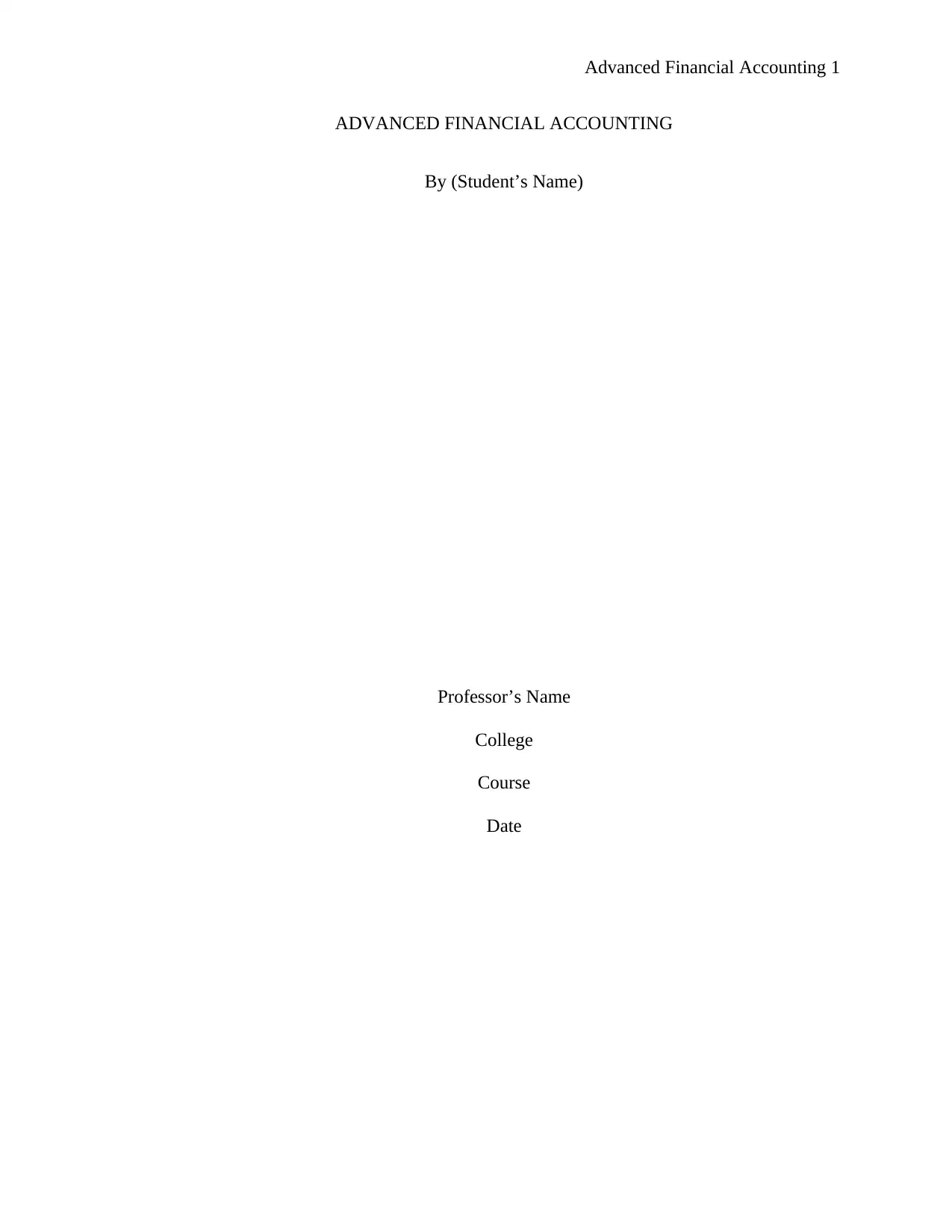
Advanced Financial Accounting 1
ADVANCED FINANCIAL ACCOUNTING
By (Student’s Name)
Professor’s Name
College
Course
Date
ADVANCED FINANCIAL ACCOUNTING
By (Student’s Name)
Professor’s Name
College
Course
Date
Paraphrase This Document
Need a fresh take? Get an instant paraphrase of this document with our AI Paraphraser
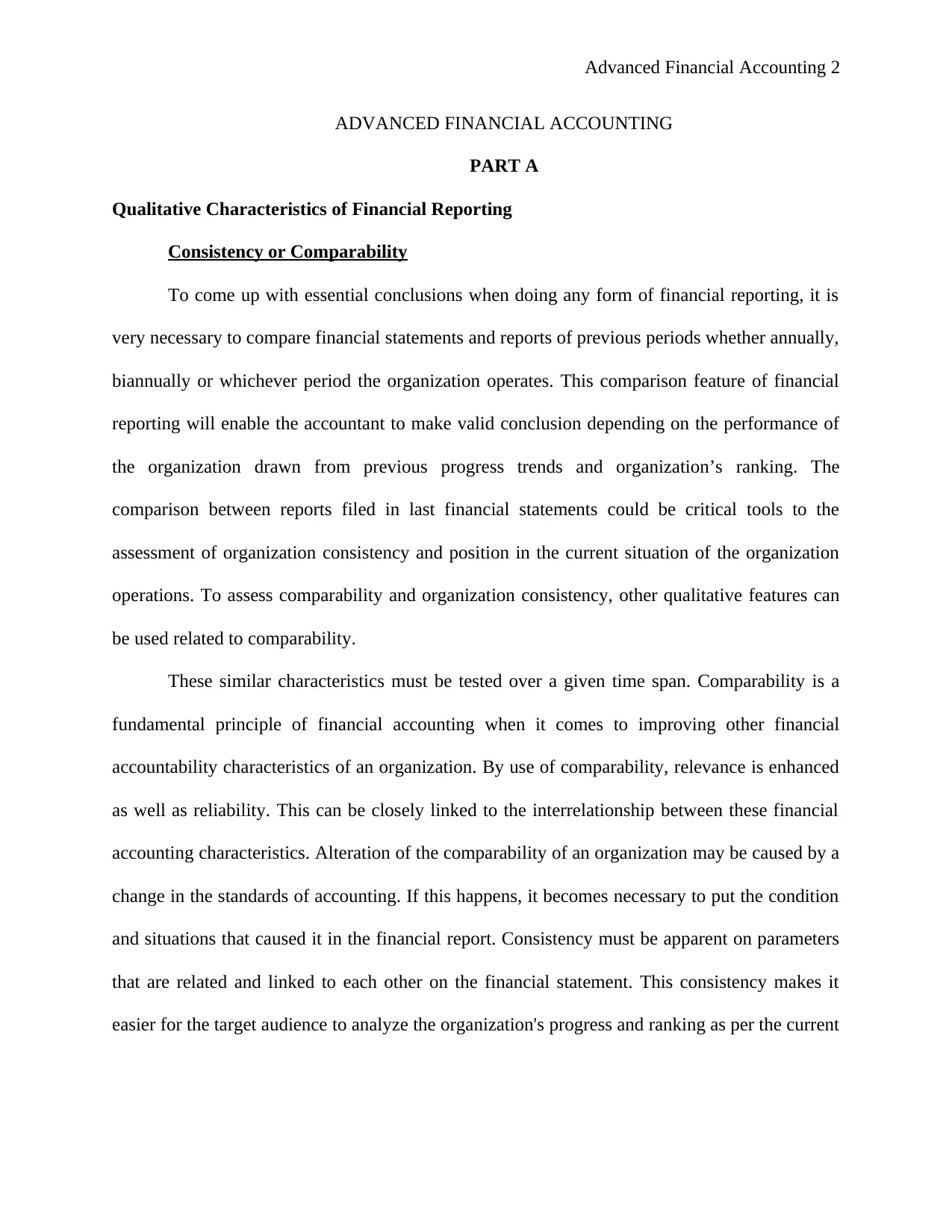
Advanced Financial Accounting 2
ADVANCED FINANCIAL ACCOUNTING
PART A
Qualitative Characteristics of Financial Reporting
Consistency or Comparability
To come up with essential conclusions when doing any form of financial reporting, it is
very necessary to compare financial statements and reports of previous periods whether annually,
biannually or whichever period the organization operates. This comparison feature of financial
reporting will enable the accountant to make valid conclusion depending on the performance of
the organization drawn from previous progress trends and organization’s ranking. The
comparison between reports filed in last financial statements could be critical tools to the
assessment of organization consistency and position in the current situation of the organization
operations. To assess comparability and organization consistency, other qualitative features can
be used related to comparability.
These similar characteristics must be tested over a given time span. Comparability is a
fundamental principle of financial accounting when it comes to improving other financial
accountability characteristics of an organization. By use of comparability, relevance is enhanced
as well as reliability. This can be closely linked to the interrelationship between these financial
accounting characteristics. Alteration of the comparability of an organization may be caused by a
change in the standards of accounting. If this happens, it becomes necessary to put the condition
and situations that caused it in the financial report. Consistency must be apparent on parameters
that are related and linked to each other on the financial statement. This consistency makes it
easier for the target audience to analyze the organization's progress and ranking as per the current
ADVANCED FINANCIAL ACCOUNTING
PART A
Qualitative Characteristics of Financial Reporting
Consistency or Comparability
To come up with essential conclusions when doing any form of financial reporting, it is
very necessary to compare financial statements and reports of previous periods whether annually,
biannually or whichever period the organization operates. This comparison feature of financial
reporting will enable the accountant to make valid conclusion depending on the performance of
the organization drawn from previous progress trends and organization’s ranking. The
comparison between reports filed in last financial statements could be critical tools to the
assessment of organization consistency and position in the current situation of the organization
operations. To assess comparability and organization consistency, other qualitative features can
be used related to comparability.
These similar characteristics must be tested over a given time span. Comparability is a
fundamental principle of financial accounting when it comes to improving other financial
accountability characteristics of an organization. By use of comparability, relevance is enhanced
as well as reliability. This can be closely linked to the interrelationship between these financial
accounting characteristics. Alteration of the comparability of an organization may be caused by a
change in the standards of accounting. If this happens, it becomes necessary to put the condition
and situations that caused it in the financial report. Consistency must be apparent on parameters
that are related and linked to each other on the financial statement. This consistency makes it
easier for the target audience to analyze the organization's progress and ranking as per the current
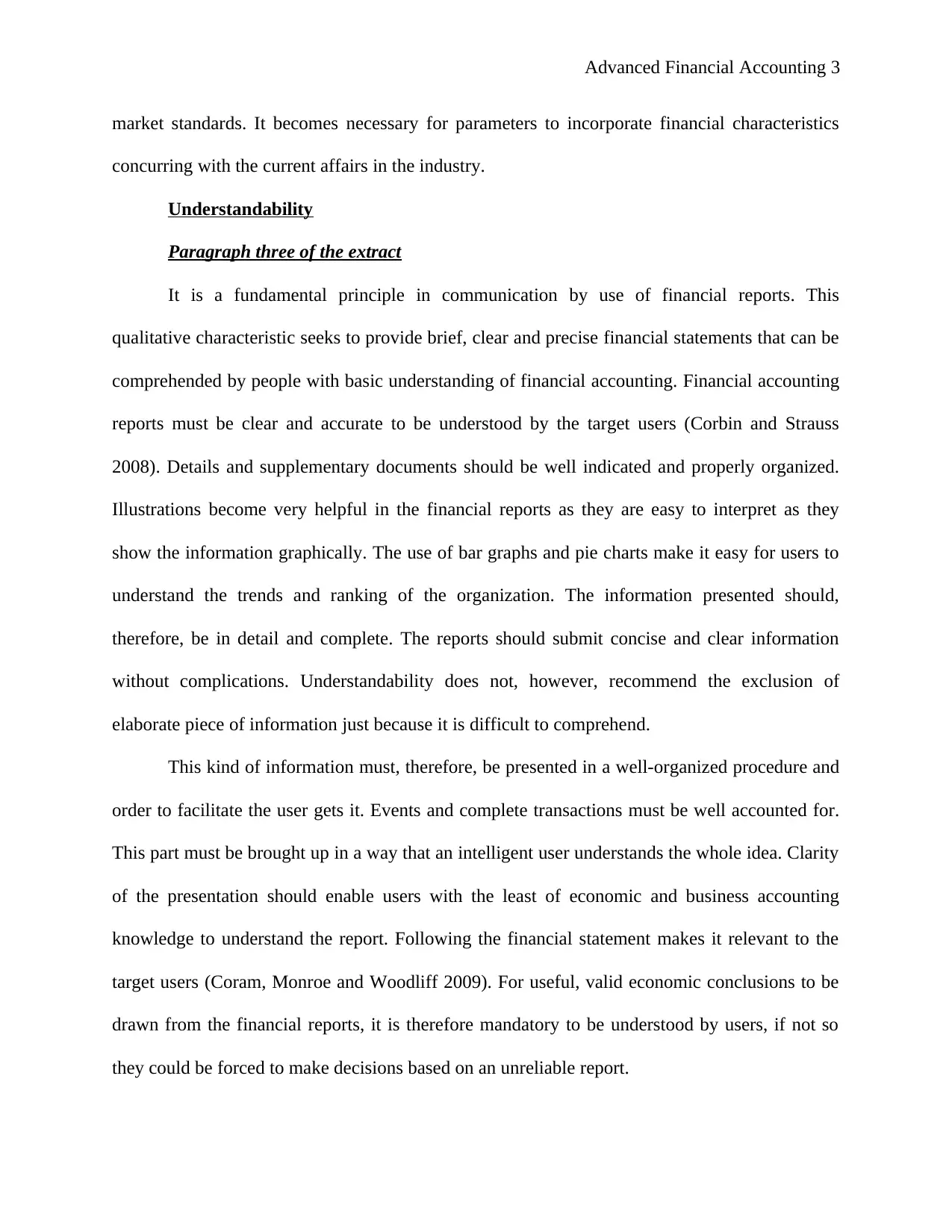
Advanced Financial Accounting 3
market standards. It becomes necessary for parameters to incorporate financial characteristics
concurring with the current affairs in the industry.
Understandability
Paragraph three of the extract
It is a fundamental principle in communication by use of financial reports. This
qualitative characteristic seeks to provide brief, clear and precise financial statements that can be
comprehended by people with basic understanding of financial accounting. Financial accounting
reports must be clear and accurate to be understood by the target users (Corbin and Strauss
2008). Details and supplementary documents should be well indicated and properly organized.
Illustrations become very helpful in the financial reports as they are easy to interpret as they
show the information graphically. The use of bar graphs and pie charts make it easy for users to
understand the trends and ranking of the organization. The information presented should,
therefore, be in detail and complete. The reports should submit concise and clear information
without complications. Understandability does not, however, recommend the exclusion of
elaborate piece of information just because it is difficult to comprehend.
This kind of information must, therefore, be presented in a well-organized procedure and
order to facilitate the user gets it. Events and complete transactions must be well accounted for.
This part must be brought up in a way that an intelligent user understands the whole idea. Clarity
of the presentation should enable users with the least of economic and business accounting
knowledge to understand the report. Following the financial statement makes it relevant to the
target users (Coram, Monroe and Woodliff 2009). For useful, valid economic conclusions to be
drawn from the financial reports, it is therefore mandatory to be understood by users, if not so
they could be forced to make decisions based on an unreliable report.
market standards. It becomes necessary for parameters to incorporate financial characteristics
concurring with the current affairs in the industry.
Understandability
Paragraph three of the extract
It is a fundamental principle in communication by use of financial reports. This
qualitative characteristic seeks to provide brief, clear and precise financial statements that can be
comprehended by people with basic understanding of financial accounting. Financial accounting
reports must be clear and accurate to be understood by the target users (Corbin and Strauss
2008). Details and supplementary documents should be well indicated and properly organized.
Illustrations become very helpful in the financial reports as they are easy to interpret as they
show the information graphically. The use of bar graphs and pie charts make it easy for users to
understand the trends and ranking of the organization. The information presented should,
therefore, be in detail and complete. The reports should submit concise and clear information
without complications. Understandability does not, however, recommend the exclusion of
elaborate piece of information just because it is difficult to comprehend.
This kind of information must, therefore, be presented in a well-organized procedure and
order to facilitate the user gets it. Events and complete transactions must be well accounted for.
This part must be brought up in a way that an intelligent user understands the whole idea. Clarity
of the presentation should enable users with the least of economic and business accounting
knowledge to understand the report. Following the financial statement makes it relevant to the
target users (Coram, Monroe and Woodliff 2009). For useful, valid economic conclusions to be
drawn from the financial reports, it is therefore mandatory to be understood by users, if not so
they could be forced to make decisions based on an unreliable report.
⊘ This is a preview!⊘
Do you want full access?
Subscribe today to unlock all pages.

Trusted by 1+ million students worldwide
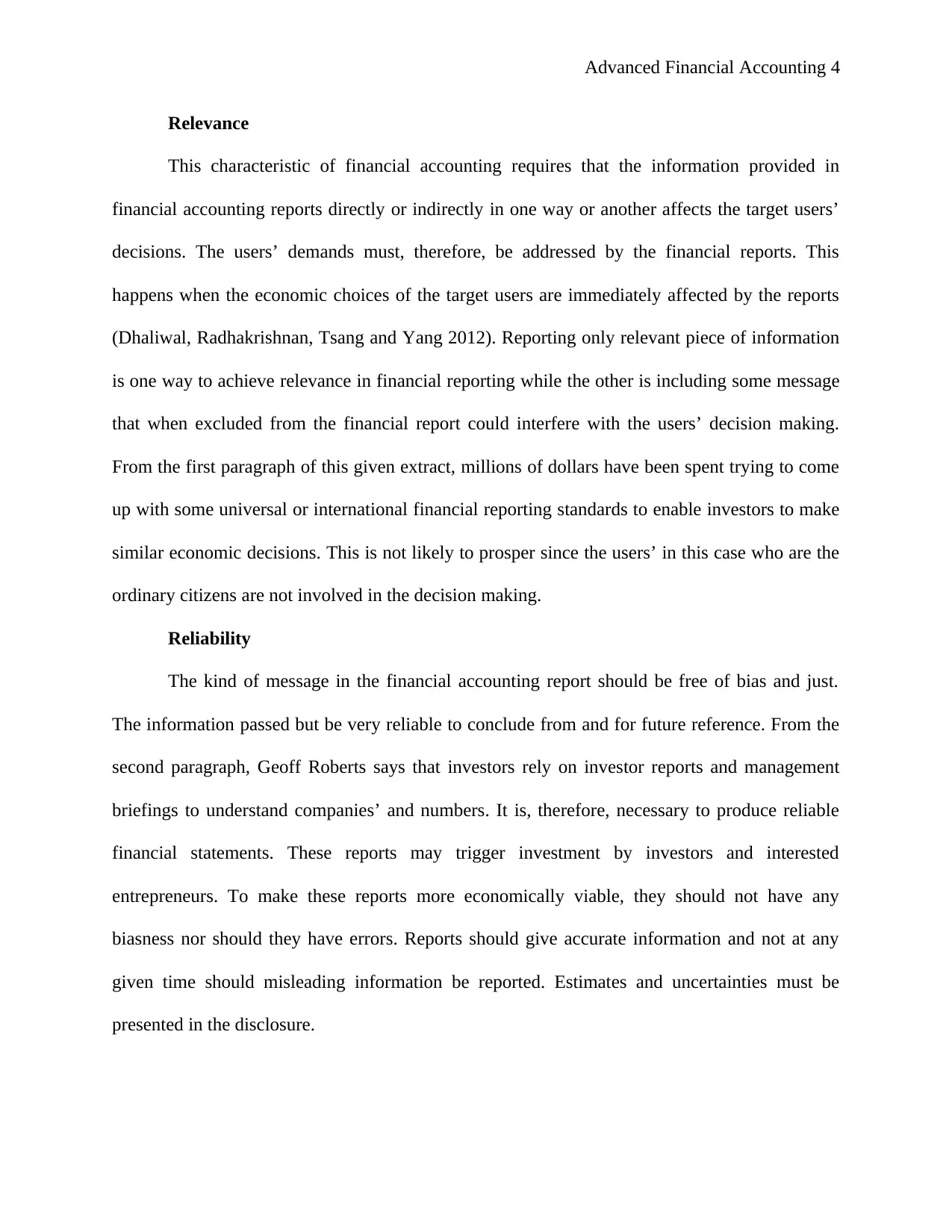
Advanced Financial Accounting 4
Relevance
This characteristic of financial accounting requires that the information provided in
financial accounting reports directly or indirectly in one way or another affects the target users’
decisions. The users’ demands must, therefore, be addressed by the financial reports. This
happens when the economic choices of the target users are immediately affected by the reports
(Dhaliwal, Radhakrishnan, Tsang and Yang 2012). Reporting only relevant piece of information
is one way to achieve relevance in financial reporting while the other is including some message
that when excluded from the financial report could interfere with the users’ decision making.
From the first paragraph of this given extract, millions of dollars have been spent trying to come
up with some universal or international financial reporting standards to enable investors to make
similar economic decisions. This is not likely to prosper since the users’ in this case who are the
ordinary citizens are not involved in the decision making.
Reliability
The kind of message in the financial accounting report should be free of bias and just.
The information passed but be very reliable to conclude from and for future reference. From the
second paragraph, Geoff Roberts says that investors rely on investor reports and management
briefings to understand companies’ and numbers. It is, therefore, necessary to produce reliable
financial statements. These reports may trigger investment by investors and interested
entrepreneurs. To make these reports more economically viable, they should not have any
biasness nor should they have errors. Reports should give accurate information and not at any
given time should misleading information be reported. Estimates and uncertainties must be
presented in the disclosure.
Relevance
This characteristic of financial accounting requires that the information provided in
financial accounting reports directly or indirectly in one way or another affects the target users’
decisions. The users’ demands must, therefore, be addressed by the financial reports. This
happens when the economic choices of the target users are immediately affected by the reports
(Dhaliwal, Radhakrishnan, Tsang and Yang 2012). Reporting only relevant piece of information
is one way to achieve relevance in financial reporting while the other is including some message
that when excluded from the financial report could interfere with the users’ decision making.
From the first paragraph of this given extract, millions of dollars have been spent trying to come
up with some universal or international financial reporting standards to enable investors to make
similar economic decisions. This is not likely to prosper since the users’ in this case who are the
ordinary citizens are not involved in the decision making.
Reliability
The kind of message in the financial accounting report should be free of bias and just.
The information passed but be very reliable to conclude from and for future reference. From the
second paragraph, Geoff Roberts says that investors rely on investor reports and management
briefings to understand companies’ and numbers. It is, therefore, necessary to produce reliable
financial statements. These reports may trigger investment by investors and interested
entrepreneurs. To make these reports more economically viable, they should not have any
biasness nor should they have errors. Reports should give accurate information and not at any
given time should misleading information be reported. Estimates and uncertainties must be
presented in the disclosure.
Paraphrase This Document
Need a fresh take? Get an instant paraphrase of this document with our AI Paraphraser
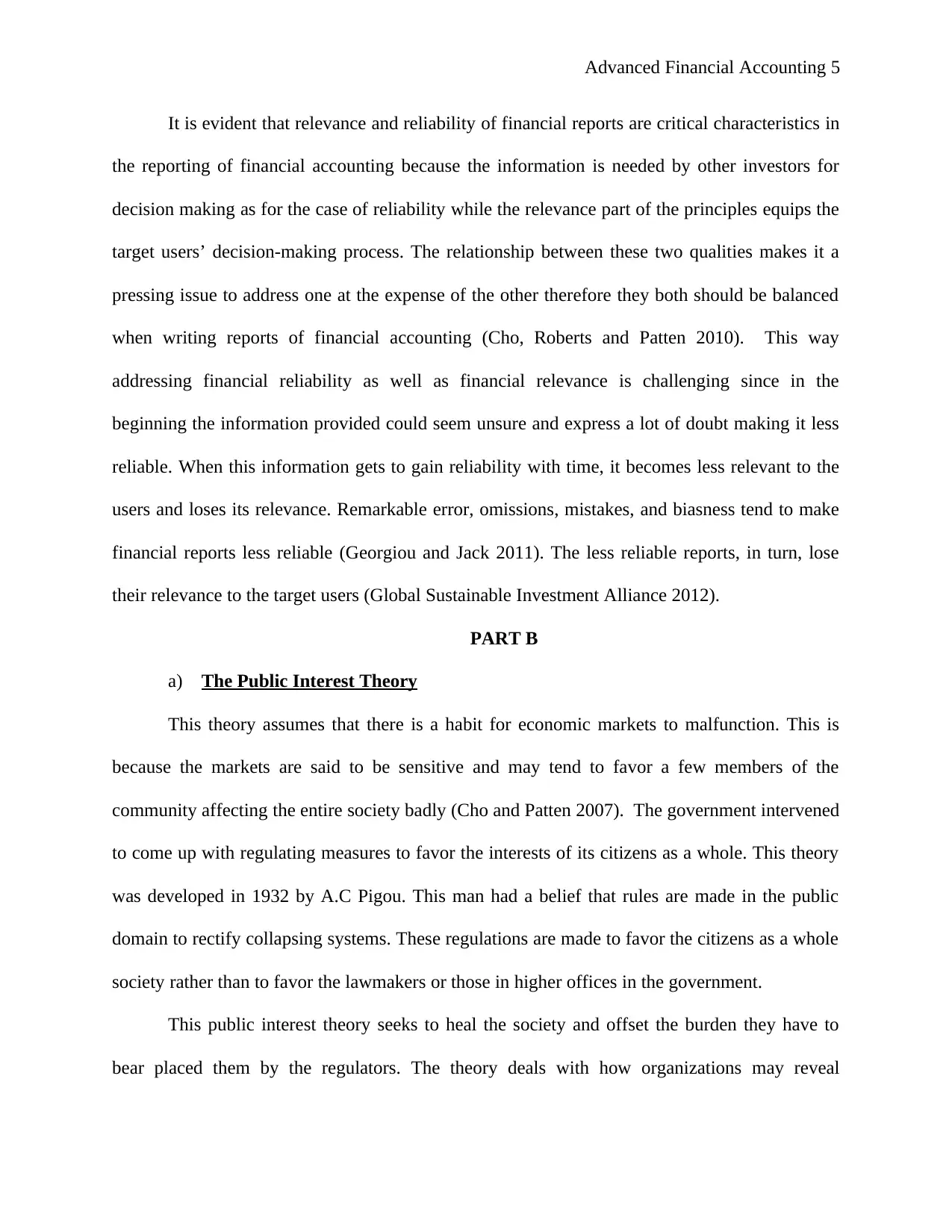
Advanced Financial Accounting 5
It is evident that relevance and reliability of financial reports are critical characteristics in
the reporting of financial accounting because the information is needed by other investors for
decision making as for the case of reliability while the relevance part of the principles equips the
target users’ decision-making process. The relationship between these two qualities makes it a
pressing issue to address one at the expense of the other therefore they both should be balanced
when writing reports of financial accounting (Cho, Roberts and Patten 2010). This way
addressing financial reliability as well as financial relevance is challenging since in the
beginning the information provided could seem unsure and express a lot of doubt making it less
reliable. When this information gets to gain reliability with time, it becomes less relevant to the
users and loses its relevance. Remarkable error, omissions, mistakes, and biasness tend to make
financial reports less reliable (Georgiou and Jack 2011). The less reliable reports, in turn, lose
their relevance to the target users (Global Sustainable Investment Alliance 2012).
PART B
a) The Public Interest Theory
This theory assumes that there is a habit for economic markets to malfunction. This is
because the markets are said to be sensitive and may tend to favor a few members of the
community affecting the entire society badly (Cho and Patten 2007). The government intervened
to come up with regulating measures to favor the interests of its citizens as a whole. This theory
was developed in 1932 by A.C Pigou. This man had a belief that rules are made in the public
domain to rectify collapsing systems. These regulations are made to favor the citizens as a whole
society rather than to favor the lawmakers or those in higher offices in the government.
This public interest theory seeks to heal the society and offset the burden they have to
bear placed them by the regulators. The theory deals with how organizations may reveal
It is evident that relevance and reliability of financial reports are critical characteristics in
the reporting of financial accounting because the information is needed by other investors for
decision making as for the case of reliability while the relevance part of the principles equips the
target users’ decision-making process. The relationship between these two qualities makes it a
pressing issue to address one at the expense of the other therefore they both should be balanced
when writing reports of financial accounting (Cho, Roberts and Patten 2010). This way
addressing financial reliability as well as financial relevance is challenging since in the
beginning the information provided could seem unsure and express a lot of doubt making it less
reliable. When this information gets to gain reliability with time, it becomes less relevant to the
users and loses its relevance. Remarkable error, omissions, mistakes, and biasness tend to make
financial reports less reliable (Georgiou and Jack 2011). The less reliable reports, in turn, lose
their relevance to the target users (Global Sustainable Investment Alliance 2012).
PART B
a) The Public Interest Theory
This theory assumes that there is a habit for economic markets to malfunction. This is
because the markets are said to be sensitive and may tend to favor a few members of the
community affecting the entire society badly (Cho and Patten 2007). The government intervened
to come up with regulating measures to favor the interests of its citizens as a whole. This theory
was developed in 1932 by A.C Pigou. This man had a belief that rules are made in the public
domain to rectify collapsing systems. These regulations are made to favor the citizens as a whole
society rather than to favor the lawmakers or those in higher offices in the government.
This public interest theory seeks to heal the society and offset the burden they have to
bear placed them by the regulators. The theory deals with how organizations may reveal
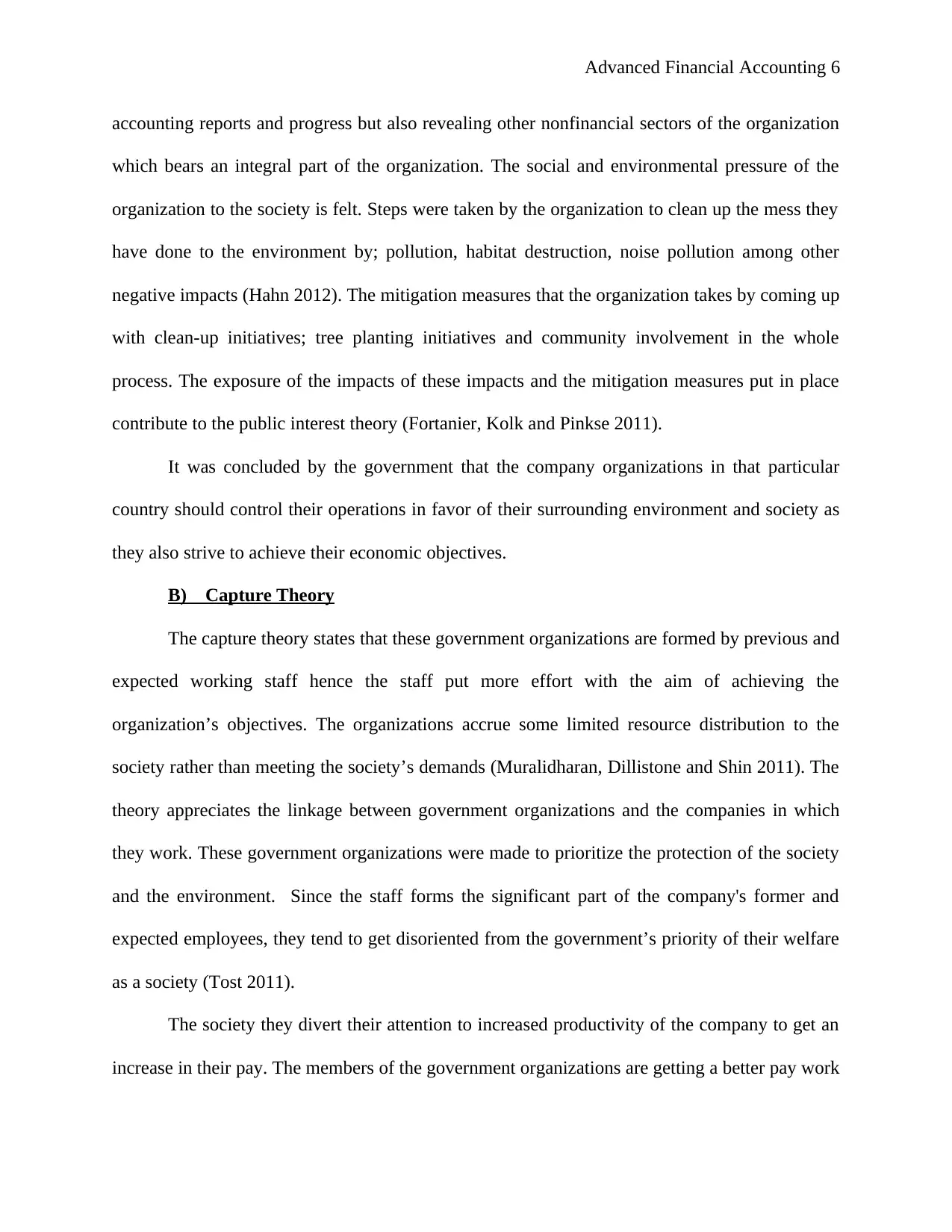
Advanced Financial Accounting 6
accounting reports and progress but also revealing other nonfinancial sectors of the organization
which bears an integral part of the organization. The social and environmental pressure of the
organization to the society is felt. Steps were taken by the organization to clean up the mess they
have done to the environment by; pollution, habitat destruction, noise pollution among other
negative impacts (Hahn 2012). The mitigation measures that the organization takes by coming up
with clean-up initiatives; tree planting initiatives and community involvement in the whole
process. The exposure of the impacts of these impacts and the mitigation measures put in place
contribute to the public interest theory (Fortanier, Kolk and Pinkse 2011).
It was concluded by the government that the company organizations in that particular
country should control their operations in favor of their surrounding environment and society as
they also strive to achieve their economic objectives.
B) Capture Theory
The capture theory states that these government organizations are formed by previous and
expected working staff hence the staff put more effort with the aim of achieving the
organization’s objectives. The organizations accrue some limited resource distribution to the
society rather than meeting the society’s demands (Muralidharan, Dillistone and Shin 2011). The
theory appreciates the linkage between government organizations and the companies in which
they work. These government organizations were made to prioritize the protection of the society
and the environment. Since the staff forms the significant part of the company's former and
expected employees, they tend to get disoriented from the government’s priority of their welfare
as a society (Tost 2011).
The society they divert their attention to increased productivity of the company to get an
increase in their pay. The members of the government organizations are getting a better pay work
accounting reports and progress but also revealing other nonfinancial sectors of the organization
which bears an integral part of the organization. The social and environmental pressure of the
organization to the society is felt. Steps were taken by the organization to clean up the mess they
have done to the environment by; pollution, habitat destruction, noise pollution among other
negative impacts (Hahn 2012). The mitigation measures that the organization takes by coming up
with clean-up initiatives; tree planting initiatives and community involvement in the whole
process. The exposure of the impacts of these impacts and the mitigation measures put in place
contribute to the public interest theory (Fortanier, Kolk and Pinkse 2011).
It was concluded by the government that the company organizations in that particular
country should control their operations in favor of their surrounding environment and society as
they also strive to achieve their economic objectives.
B) Capture Theory
The capture theory states that these government organizations are formed by previous and
expected working staff hence the staff put more effort with the aim of achieving the
organization’s objectives. The organizations accrue some limited resource distribution to the
society rather than meeting the society’s demands (Muralidharan, Dillistone and Shin 2011). The
theory appreciates the linkage between government organizations and the companies in which
they work. These government organizations were made to prioritize the protection of the society
and the environment. Since the staff forms the significant part of the company's former and
expected employees, they tend to get disoriented from the government’s priority of their welfare
as a society (Tost 2011).
The society they divert their attention to increased productivity of the company to get an
increase in their pay. The members of the government organizations are getting a better pay work
⊘ This is a preview!⊘
Do you want full access?
Subscribe today to unlock all pages.

Trusted by 1+ million students worldwide
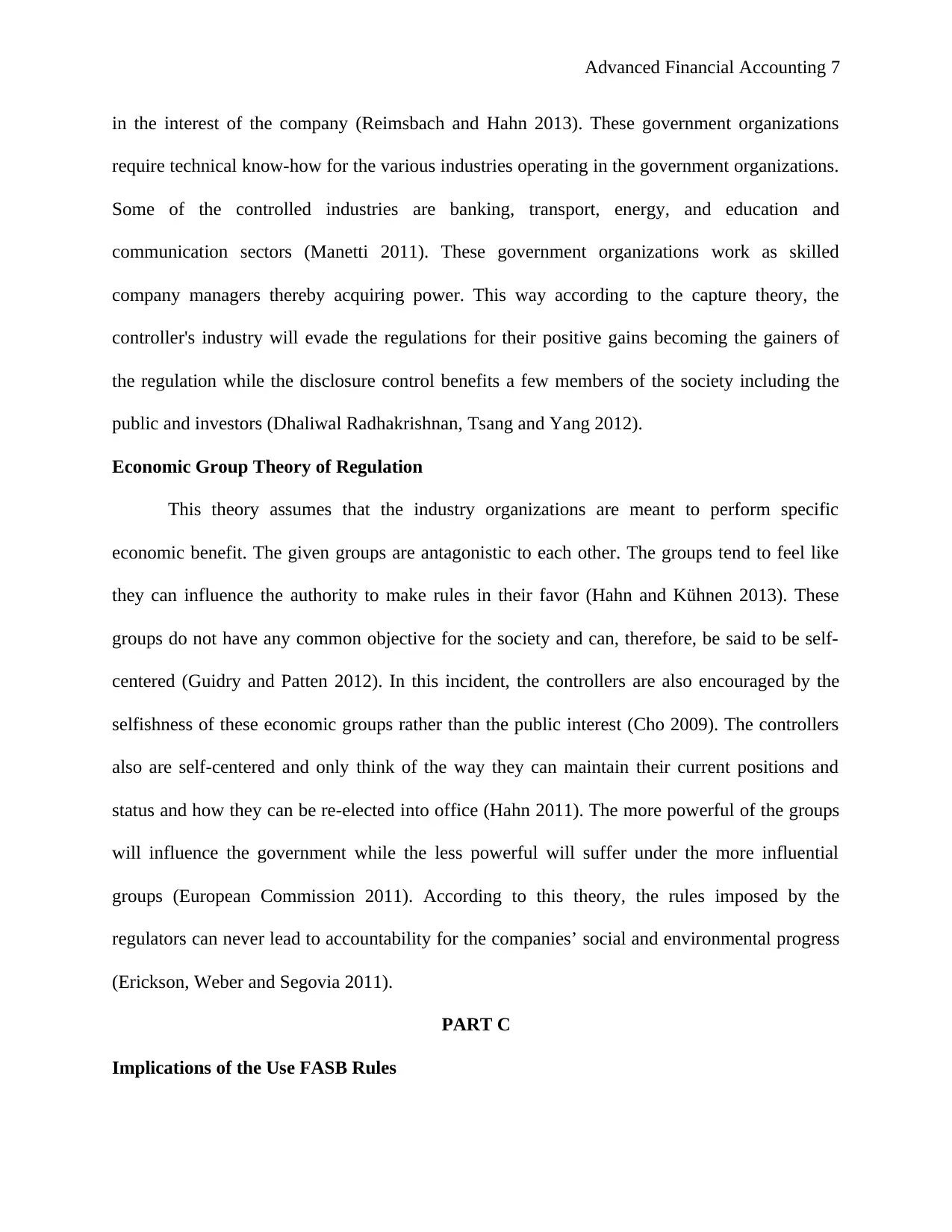
Advanced Financial Accounting 7
in the interest of the company (Reimsbach and Hahn 2013). These government organizations
require technical know-how for the various industries operating in the government organizations.
Some of the controlled industries are banking, transport, energy, and education and
communication sectors (Manetti 2011). These government organizations work as skilled
company managers thereby acquiring power. This way according to the capture theory, the
controller's industry will evade the regulations for their positive gains becoming the gainers of
the regulation while the disclosure control benefits a few members of the society including the
public and investors (Dhaliwal Radhakrishnan, Tsang and Yang 2012).
Economic Group Theory of Regulation
This theory assumes that the industry organizations are meant to perform specific
economic benefit. The given groups are antagonistic to each other. The groups tend to feel like
they can influence the authority to make rules in their favor (Hahn and Kühnen 2013). These
groups do not have any common objective for the society and can, therefore, be said to be self-
centered (Guidry and Patten 2012). In this incident, the controllers are also encouraged by the
selfishness of these economic groups rather than the public interest (Cho 2009). The controllers
also are self-centered and only think of the way they can maintain their current positions and
status and how they can be re-elected into office (Hahn 2011). The more powerful of the groups
will influence the government while the less powerful will suffer under the more influential
groups (European Commission 2011). According to this theory, the rules imposed by the
regulators can never lead to accountability for the companies’ social and environmental progress
(Erickson, Weber and Segovia 2011).
PART C
Implications of the Use FASB Rules
in the interest of the company (Reimsbach and Hahn 2013). These government organizations
require technical know-how for the various industries operating in the government organizations.
Some of the controlled industries are banking, transport, energy, and education and
communication sectors (Manetti 2011). These government organizations work as skilled
company managers thereby acquiring power. This way according to the capture theory, the
controller's industry will evade the regulations for their positive gains becoming the gainers of
the regulation while the disclosure control benefits a few members of the society including the
public and investors (Dhaliwal Radhakrishnan, Tsang and Yang 2012).
Economic Group Theory of Regulation
This theory assumes that the industry organizations are meant to perform specific
economic benefit. The given groups are antagonistic to each other. The groups tend to feel like
they can influence the authority to make rules in their favor (Hahn and Kühnen 2013). These
groups do not have any common objective for the society and can, therefore, be said to be self-
centered (Guidry and Patten 2012). In this incident, the controllers are also encouraged by the
selfishness of these economic groups rather than the public interest (Cho 2009). The controllers
also are self-centered and only think of the way they can maintain their current positions and
status and how they can be re-elected into office (Hahn 2011). The more powerful of the groups
will influence the government while the less powerful will suffer under the more influential
groups (European Commission 2011). According to this theory, the rules imposed by the
regulators can never lead to accountability for the companies’ social and environmental progress
(Erickson, Weber and Segovia 2011).
PART C
Implications of the Use FASB Rules
Paraphrase This Document
Need a fresh take? Get an instant paraphrase of this document with our AI Paraphraser
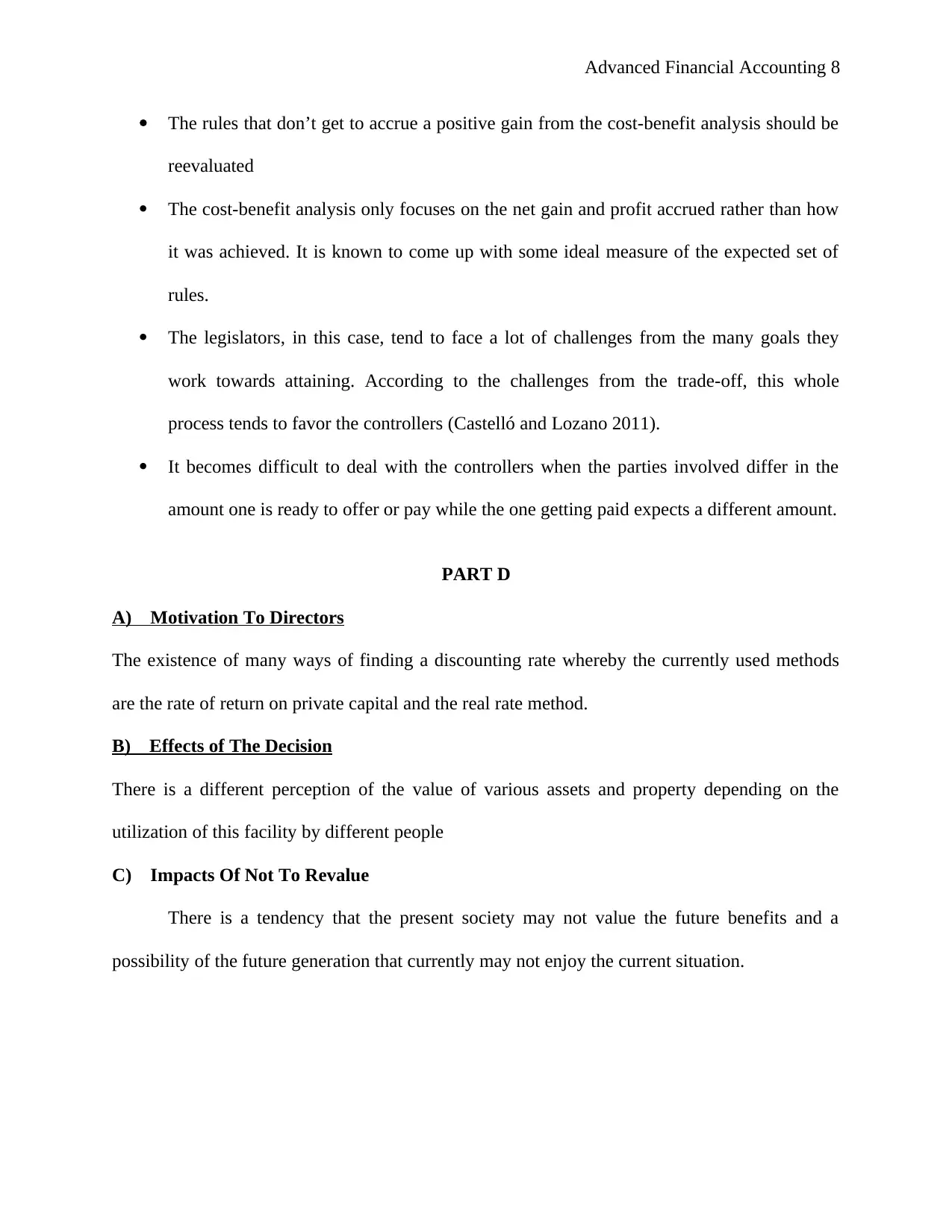
Advanced Financial Accounting 8
The rules that don’t get to accrue a positive gain from the cost-benefit analysis should be
reevaluated
The cost-benefit analysis only focuses on the net gain and profit accrued rather than how
it was achieved. It is known to come up with some ideal measure of the expected set of
rules.
The legislators, in this case, tend to face a lot of challenges from the many goals they
work towards attaining. According to the challenges from the trade-off, this whole
process tends to favor the controllers (Castelló and Lozano 2011).
It becomes difficult to deal with the controllers when the parties involved differ in the
amount one is ready to offer or pay while the one getting paid expects a different amount.
PART D
A) Motivation To Directors
The existence of many ways of finding a discounting rate whereby the currently used methods
are the rate of return on private capital and the real rate method.
B) Effects of The Decision
There is a different perception of the value of various assets and property depending on the
utilization of this facility by different people
C) Impacts Of Not To Revalue
There is a tendency that the present society may not value the future benefits and a
possibility of the future generation that currently may not enjoy the current situation.
The rules that don’t get to accrue a positive gain from the cost-benefit analysis should be
reevaluated
The cost-benefit analysis only focuses on the net gain and profit accrued rather than how
it was achieved. It is known to come up with some ideal measure of the expected set of
rules.
The legislators, in this case, tend to face a lot of challenges from the many goals they
work towards attaining. According to the challenges from the trade-off, this whole
process tends to favor the controllers (Castelló and Lozano 2011).
It becomes difficult to deal with the controllers when the parties involved differ in the
amount one is ready to offer or pay while the one getting paid expects a different amount.
PART D
A) Motivation To Directors
The existence of many ways of finding a discounting rate whereby the currently used methods
are the rate of return on private capital and the real rate method.
B) Effects of The Decision
There is a different perception of the value of various assets and property depending on the
utilization of this facility by different people
C) Impacts Of Not To Revalue
There is a tendency that the present society may not value the future benefits and a
possibility of the future generation that currently may not enjoy the current situation.
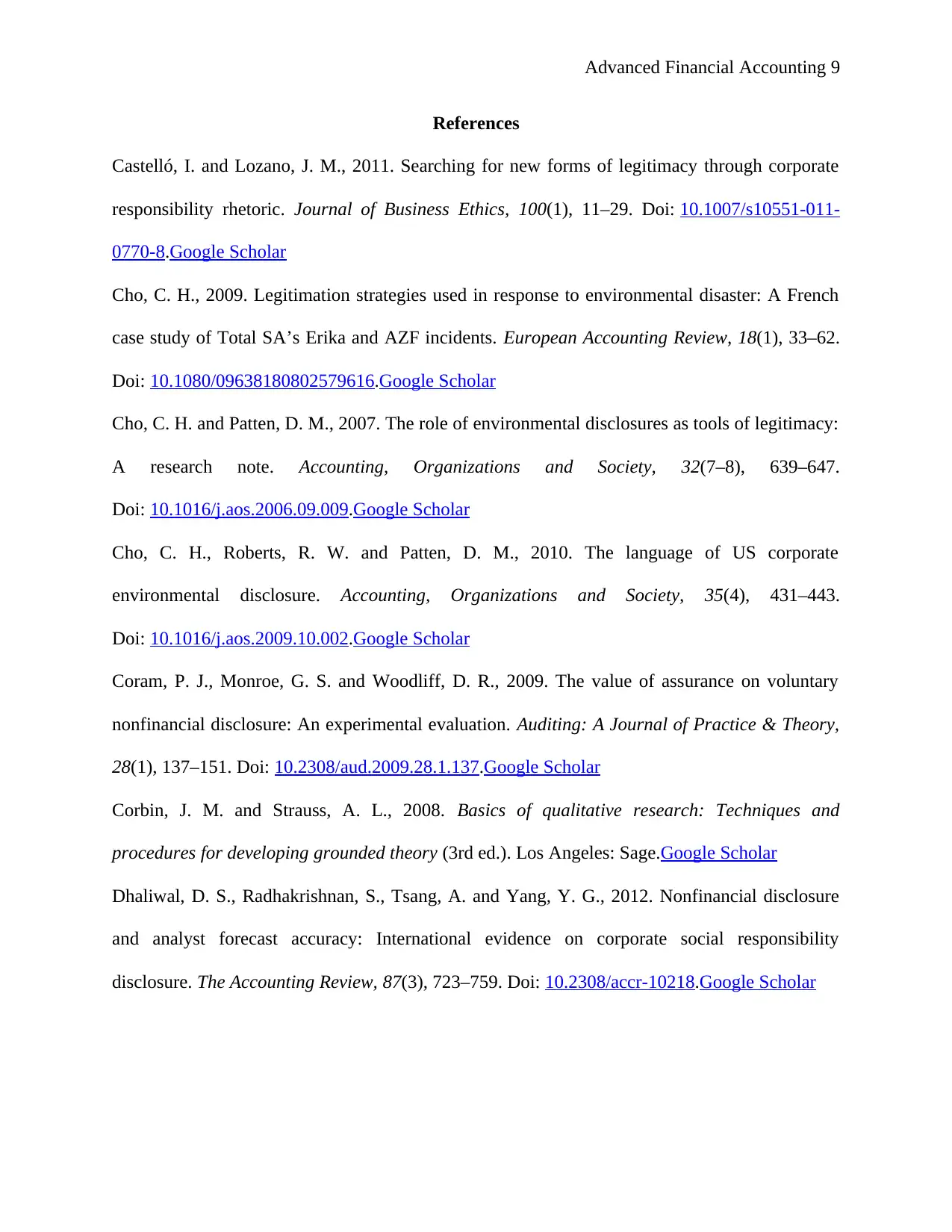
Advanced Financial Accounting 9
References
Castelló, I. and Lozano, J. M., 2011. Searching for new forms of legitimacy through corporate
responsibility rhetoric. Journal of Business Ethics, 100(1), 11–29. Doi: 10.1007/s10551-011-
0770-8.Google Scholar
Cho, C. H., 2009. Legitimation strategies used in response to environmental disaster: A French
case study of Total SA’s Erika and AZF incidents. European Accounting Review, 18(1), 33–62.
Doi: 10.1080/09638180802579616.Google Scholar
Cho, C. H. and Patten, D. M., 2007. The role of environmental disclosures as tools of legitimacy:
A research note. Accounting, Organizations and Society, 32(7–8), 639–647.
Doi: 10.1016/j.aos.2006.09.009.Google Scholar
Cho, C. H., Roberts, R. W. and Patten, D. M., 2010. The language of US corporate
environmental disclosure. Accounting, Organizations and Society, 35(4), 431–443.
Doi: 10.1016/j.aos.2009.10.002.Google Scholar
Coram, P. J., Monroe, G. S. and Woodliff, D. R., 2009. The value of assurance on voluntary
nonfinancial disclosure: An experimental evaluation. Auditing: A Journal of Practice & Theory,
28(1), 137–151. Doi: 10.2308/aud.2009.28.1.137.Google Scholar
Corbin, J. M. and Strauss, A. L., 2008. Basics of qualitative research: Techniques and
procedures for developing grounded theory (3rd ed.). Los Angeles: Sage.Google Scholar
Dhaliwal, D. S., Radhakrishnan, S., Tsang, A. and Yang, Y. G., 2012. Nonfinancial disclosure
and analyst forecast accuracy: International evidence on corporate social responsibility
disclosure. The Accounting Review, 87(3), 723–759. Doi: 10.2308/accr-10218.Google Scholar
References
Castelló, I. and Lozano, J. M., 2011. Searching for new forms of legitimacy through corporate
responsibility rhetoric. Journal of Business Ethics, 100(1), 11–29. Doi: 10.1007/s10551-011-
0770-8.Google Scholar
Cho, C. H., 2009. Legitimation strategies used in response to environmental disaster: A French
case study of Total SA’s Erika and AZF incidents. European Accounting Review, 18(1), 33–62.
Doi: 10.1080/09638180802579616.Google Scholar
Cho, C. H. and Patten, D. M., 2007. The role of environmental disclosures as tools of legitimacy:
A research note. Accounting, Organizations and Society, 32(7–8), 639–647.
Doi: 10.1016/j.aos.2006.09.009.Google Scholar
Cho, C. H., Roberts, R. W. and Patten, D. M., 2010. The language of US corporate
environmental disclosure. Accounting, Organizations and Society, 35(4), 431–443.
Doi: 10.1016/j.aos.2009.10.002.Google Scholar
Coram, P. J., Monroe, G. S. and Woodliff, D. R., 2009. The value of assurance on voluntary
nonfinancial disclosure: An experimental evaluation. Auditing: A Journal of Practice & Theory,
28(1), 137–151. Doi: 10.2308/aud.2009.28.1.137.Google Scholar
Corbin, J. M. and Strauss, A. L., 2008. Basics of qualitative research: Techniques and
procedures for developing grounded theory (3rd ed.). Los Angeles: Sage.Google Scholar
Dhaliwal, D. S., Radhakrishnan, S., Tsang, A. and Yang, Y. G., 2012. Nonfinancial disclosure
and analyst forecast accuracy: International evidence on corporate social responsibility
disclosure. The Accounting Review, 87(3), 723–759. Doi: 10.2308/accr-10218.Google Scholar
⊘ This is a preview!⊘
Do you want full access?
Subscribe today to unlock all pages.

Trusted by 1+ million students worldwide
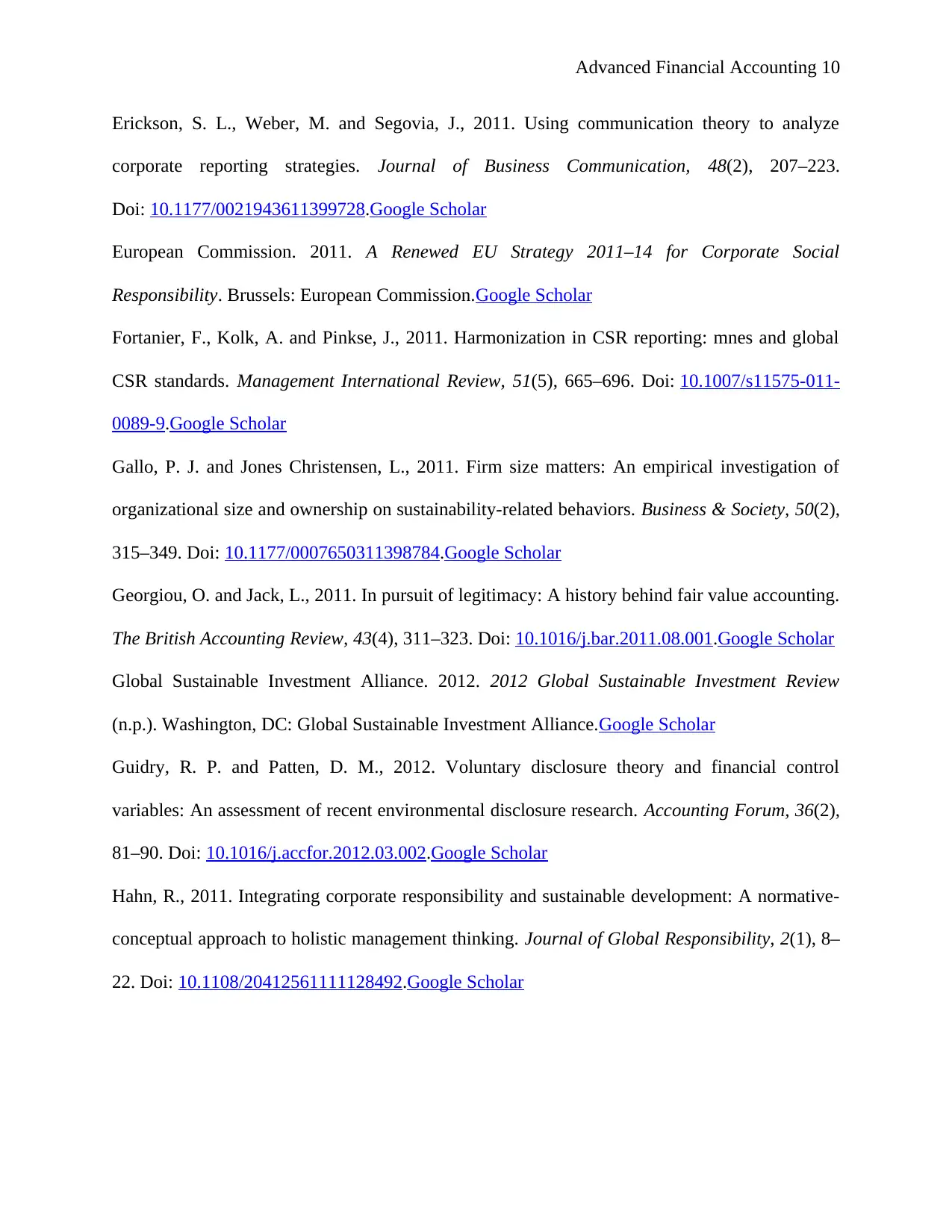
Advanced Financial Accounting 10
Erickson, S. L., Weber, M. and Segovia, J., 2011. Using communication theory to analyze
corporate reporting strategies. Journal of Business Communication, 48(2), 207–223.
Doi: 10.1177/0021943611399728.Google Scholar
European Commission. 2011. A Renewed EU Strategy 2011–14 for Corporate Social
Responsibility. Brussels: European Commission.Google Scholar
Fortanier, F., Kolk, A. and Pinkse, J., 2011. Harmonization in CSR reporting: mnes and global
CSR standards. Management International Review, 51(5), 665–696. Doi: 10.1007/s11575-011-
0089-9.Google Scholar
Gallo, P. J. and Jones Christensen, L., 2011. Firm size matters: An empirical investigation of
organizational size and ownership on sustainability-related behaviors. Business & Society, 50(2),
315–349. Doi: 10.1177/0007650311398784.Google Scholar
Georgiou, O. and Jack, L., 2011. In pursuit of legitimacy: A history behind fair value accounting.
The British Accounting Review, 43(4), 311–323. Doi: 10.1016/j.bar.2011.08.001.Google Scholar
Global Sustainable Investment Alliance. 2012. 2012 Global Sustainable Investment Review
(n.p.). Washington, DC: Global Sustainable Investment Alliance.Google Scholar
Guidry, R. P. and Patten, D. M., 2012. Voluntary disclosure theory and financial control
variables: An assessment of recent environmental disclosure research. Accounting Forum, 36(2),
81–90. Doi: 10.1016/j.accfor.2012.03.002.Google Scholar
Hahn, R., 2011. Integrating corporate responsibility and sustainable development: A normative-
conceptual approach to holistic management thinking. Journal of Global Responsibility, 2(1), 8–
22. Doi: 10.1108/20412561111128492.Google Scholar
Erickson, S. L., Weber, M. and Segovia, J., 2011. Using communication theory to analyze
corporate reporting strategies. Journal of Business Communication, 48(2), 207–223.
Doi: 10.1177/0021943611399728.Google Scholar
European Commission. 2011. A Renewed EU Strategy 2011–14 for Corporate Social
Responsibility. Brussels: European Commission.Google Scholar
Fortanier, F., Kolk, A. and Pinkse, J., 2011. Harmonization in CSR reporting: mnes and global
CSR standards. Management International Review, 51(5), 665–696. Doi: 10.1007/s11575-011-
0089-9.Google Scholar
Gallo, P. J. and Jones Christensen, L., 2011. Firm size matters: An empirical investigation of
organizational size and ownership on sustainability-related behaviors. Business & Society, 50(2),
315–349. Doi: 10.1177/0007650311398784.Google Scholar
Georgiou, O. and Jack, L., 2011. In pursuit of legitimacy: A history behind fair value accounting.
The British Accounting Review, 43(4), 311–323. Doi: 10.1016/j.bar.2011.08.001.Google Scholar
Global Sustainable Investment Alliance. 2012. 2012 Global Sustainable Investment Review
(n.p.). Washington, DC: Global Sustainable Investment Alliance.Google Scholar
Guidry, R. P. and Patten, D. M., 2012. Voluntary disclosure theory and financial control
variables: An assessment of recent environmental disclosure research. Accounting Forum, 36(2),
81–90. Doi: 10.1016/j.accfor.2012.03.002.Google Scholar
Hahn, R., 2011. Integrating corporate responsibility and sustainable development: A normative-
conceptual approach to holistic management thinking. Journal of Global Responsibility, 2(1), 8–
22. Doi: 10.1108/20412561111128492.Google Scholar
Paraphrase This Document
Need a fresh take? Get an instant paraphrase of this document with our AI Paraphraser
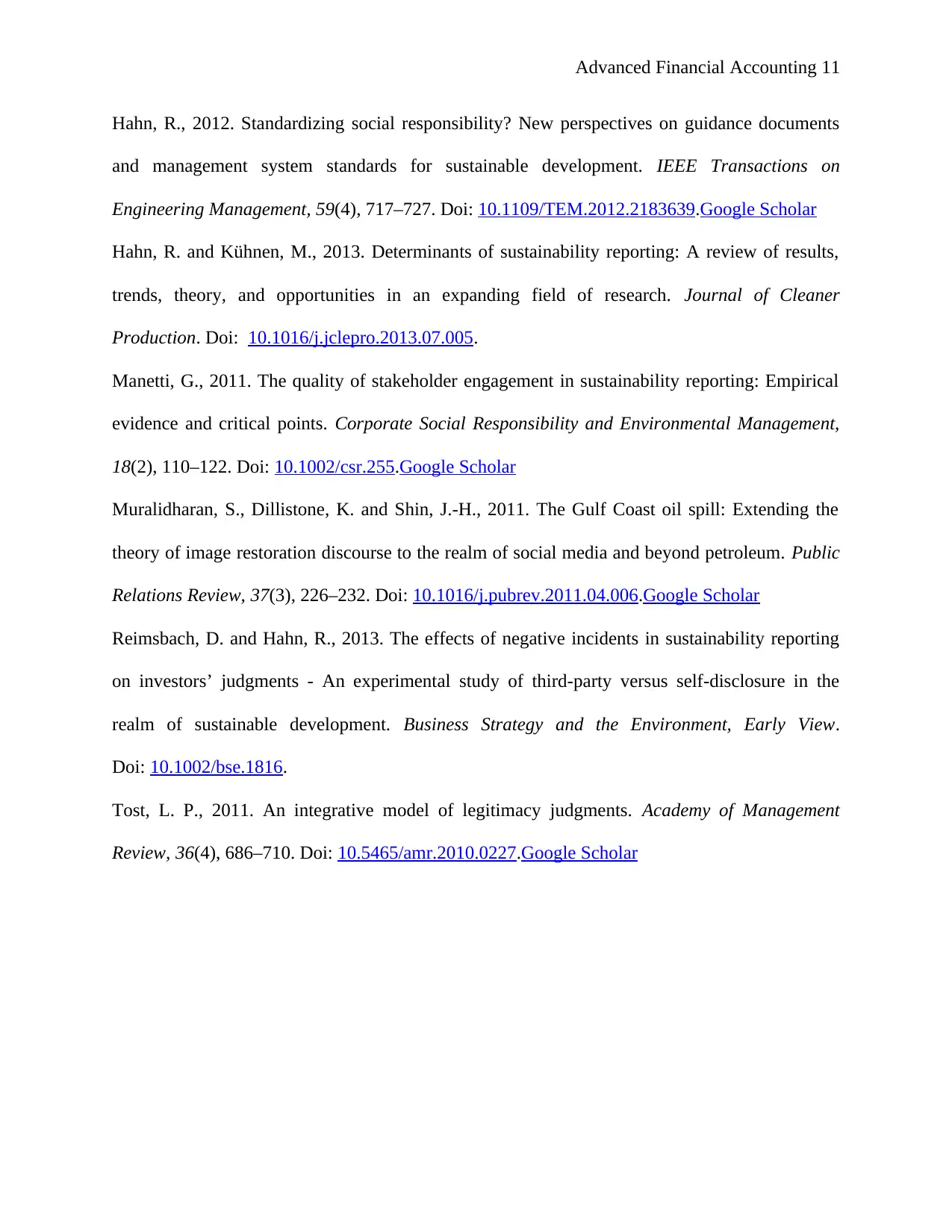
Advanced Financial Accounting 11
Hahn, R., 2012. Standardizing social responsibility? New perspectives on guidance documents
and management system standards for sustainable development. IEEE Transactions on
Engineering Management, 59(4), 717–727. Doi: 10.1109/TEM.2012.2183639.Google Scholar
Hahn, R. and Kühnen, M., 2013. Determinants of sustainability reporting: A review of results,
trends, theory, and opportunities in an expanding field of research. Journal of Cleaner
Production. Doi: 10.1016/j.jclepro.2013.07.005.
Manetti, G., 2011. The quality of stakeholder engagement in sustainability reporting: Empirical
evidence and critical points. Corporate Social Responsibility and Environmental Management,
18(2), 110–122. Doi: 10.1002/csr.255.Google Scholar
Muralidharan, S., Dillistone, K. and Shin, J.-H., 2011. The Gulf Coast oil spill: Extending the
theory of image restoration discourse to the realm of social media and beyond petroleum. Public
Relations Review, 37(3), 226–232. Doi: 10.1016/j.pubrev.2011.04.006.Google Scholar
Reimsbach, D. and Hahn, R., 2013. The effects of negative incidents in sustainability reporting
on investors’ judgments - An experimental study of third-party versus self-disclosure in the
realm of sustainable development. Business Strategy and the Environment, Early View.
Doi: 10.1002/bse.1816.
Tost, L. P., 2011. An integrative model of legitimacy judgments. Academy of Management
Review, 36(4), 686–710. Doi: 10.5465/amr.2010.0227.Google Scholar
Hahn, R., 2012. Standardizing social responsibility? New perspectives on guidance documents
and management system standards for sustainable development. IEEE Transactions on
Engineering Management, 59(4), 717–727. Doi: 10.1109/TEM.2012.2183639.Google Scholar
Hahn, R. and Kühnen, M., 2013. Determinants of sustainability reporting: A review of results,
trends, theory, and opportunities in an expanding field of research. Journal of Cleaner
Production. Doi: 10.1016/j.jclepro.2013.07.005.
Manetti, G., 2011. The quality of stakeholder engagement in sustainability reporting: Empirical
evidence and critical points. Corporate Social Responsibility and Environmental Management,
18(2), 110–122. Doi: 10.1002/csr.255.Google Scholar
Muralidharan, S., Dillistone, K. and Shin, J.-H., 2011. The Gulf Coast oil spill: Extending the
theory of image restoration discourse to the realm of social media and beyond petroleum. Public
Relations Review, 37(3), 226–232. Doi: 10.1016/j.pubrev.2011.04.006.Google Scholar
Reimsbach, D. and Hahn, R., 2013. The effects of negative incidents in sustainability reporting
on investors’ judgments - An experimental study of third-party versus self-disclosure in the
realm of sustainable development. Business Strategy and the Environment, Early View.
Doi: 10.1002/bse.1816.
Tost, L. P., 2011. An integrative model of legitimacy judgments. Academy of Management
Review, 36(4), 686–710. Doi: 10.5465/amr.2010.0227.Google Scholar
1 out of 11
Related Documents
Your All-in-One AI-Powered Toolkit for Academic Success.
+13062052269
info@desklib.com
Available 24*7 on WhatsApp / Email
![[object Object]](/_next/static/media/star-bottom.7253800d.svg)
Unlock your academic potential
Copyright © 2020–2025 A2Z Services. All Rights Reserved. Developed and managed by ZUCOL.




